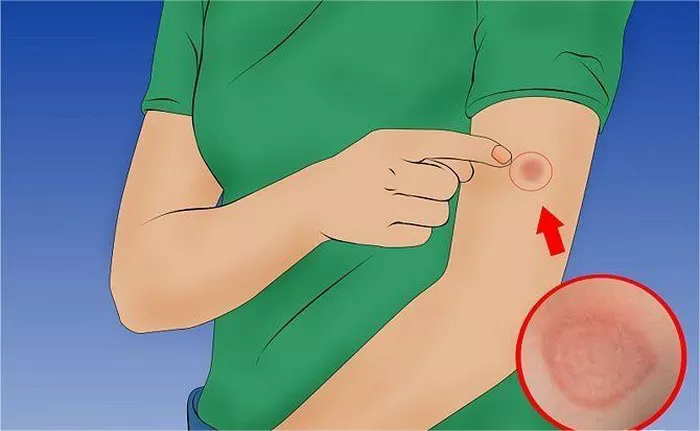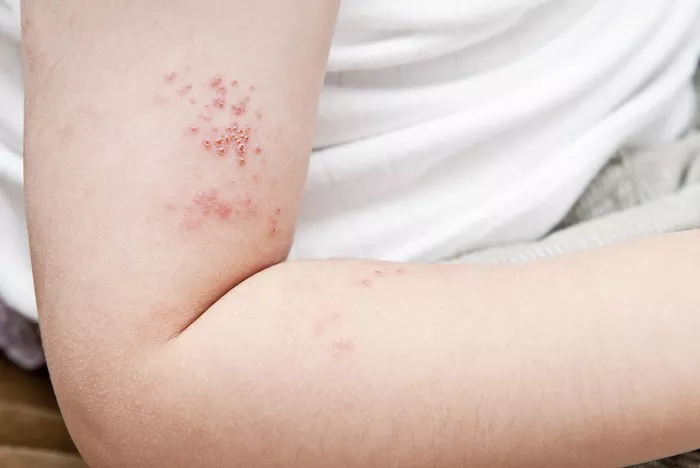Ringworm is a common fungal infection that affects the skin, hair, or nails. Despite its name, it has nothing to do with worms. It’s called ringworm because of the ring-like, red patches it forms on the skin. The infection is caused by dermatophytes, a group of fungi that thrive in warm, moist environments. Ringworm can affect anyone, and it’s highly contagious. Understanding what ringworm looks like as it heals is important for determining whether the treatment is working and how to manage the infection effectively. This article will describe how a healing ringworm looks, what changes occur during recovery, and how to ensure proper treatment.
What Is Ringworm?
Ringworm, or dermatophytosis, is a fungal infection that can appear on various parts of the body, including the scalp, feet (athlete’s foot), groin (jock itch), and nails. The fungi responsible for ringworm feed on keratin, a protein found in the skin, hair, and nails. Ringworm typically appears as a red, scaly, and itchy rash, often forming a circular pattern with clearer skin in the middle, which resembles a ring.
Symptoms of Ringworm
Before understanding how ringworm heals, it’s important to recognize the symptoms of the active infection. Common signs include:
Red, scaly, or itchy patches on the skin
Circular, ring-like appearance of the rash
Raised, inflamed borders with clearer skin in the center
Blisters or pus-filled bumps (in severe cases)
Brittle or discolored nails if the infection affects the nails
Hair loss if ringworm affects the scalp
These symptoms usually appear 4-14 days after exposure to the fungi.
SEE ALSO: Preventing 5 Ringworm Transmission from Cats to Humans
How Long Does Ringworm Take to Heal?
The healing time for ringworm varies depending on the severity of the infection, the affected area, and the treatment used. In general:
Mild cases of ringworm may heal within 2-4 weeks with proper treatment.
Severe or widespread infections may take longer, sometimes up to 6 weeks or more.
Ringworm of the scalp or nails can be particularly stubborn and may require oral antifungal medications, with healing taking several months.
Proper treatment is key to a successful recovery and to prevent the infection from spreading to others.
Stages of Ringworm Healing
As ringworm heals, its appearance changes. It’s essential to understand these changes so you can monitor your progress and ensure the infection is responding to treatment.
Stage 1: Initial Treatment and Reduction of Symptoms
Once you begin treatment (usually with antifungal creams or oral medication), the first sign of healing is often a reduction in symptoms like itching, redness, and scaling. During this stage:
Itching decreases: The infected area may still be itchy, but the intensity of the itchiness will lessen as the antifungal treatment starts to kill the fungus.
Redness and inflammation subside: The red, inflamed ring surrounding the rash will start to fade, although the area may remain discolored.
The borders become less defined: The raised, scaly edge of the ringworm rash will begin to flatten and blend in with the surrounding skin.
While these are positive signs, the infection is not fully healed yet. It’s important to continue treatment even if symptoms seem to improve.
Stage 2: Drying and Flaking
As the infection continues to heal, the affected skin will likely start to dry out and flake. This is a normal part of the healing process:
Dry, flaky skin: The area where the rash once was may become dry and begin to flake or peel as the skin regenerates.
Less redness: The red or pink coloration of the rash will continue to fade. However, the skin may still appear discolored compared to the surrounding healthy skin.
Reduced swelling: Any swelling around the ringworm patch will gradually diminish.
It’s important to keep the area clean and dry, as moisture can promote fungal growth and slow down healing.
Stage 3: Lightening or Darkening of the Skin
As the healing progresses, the skin where the ringworm was may not immediately return to its normal appearance. Instead, it may temporarily lighten or darken:
Post-inflammatory hypopigmentation: In some cases, the skin may appear lighter than the surrounding skin as it heals. This is known as hypopigmentation and is common with many types of skin infections or inflammations.
Post-inflammatory hyperpigmentation: In other cases, the healing area may appear darker than the surrounding skin, known as hyperpigmentation. This is more common in individuals with darker skin tones.
These pigment changes are usually temporary and will resolve over time as the skin continues to regenerate.
Stage 4: Complete Healing and Restoration of Skin
Once the ringworm infection is fully eradicated, the skin will continue to heal and return to its normal state:
Smooth, healthy skin: The affected area should eventually regain its normal texture and appearance. Any dryness, flakiness, or discoloration will fade, and the skin will look smooth and healthy again.
No more itching or irritation: The area will no longer be itchy or uncomfortable, indicating that the infection is completely gone.
Faded marks: In some cases, especially with more severe infections, there may be slight marks or discoloration left behind, but these will gradually fade with time.
It’s important to note that even though the skin appears healed, you should continue using the prescribed antifungal treatment for the full course to ensure the fungus is completely eradicated.
Signs That Ringworm Is Not Healing
While ringworm generally responds well to treatment, there are cases where the infection may not heal as expected. If you notice any of the following signs, it could indicate that the treatment isn’t working, and you should consult a healthcare provider:
Persistent redness and itching: If the rash remains red, inflamed, or itchy despite treatment, it could mean the infection is still active.
Worsening of the rash: If the rash is spreading or becoming more severe, it’s a sign that the infection is not responding to treatment.
Blisters or pus-filled bumps: The development of blisters or bumps filled with pus can indicate a secondary infection or a more severe fungal infection.
New patches of ringworm: If new patches of ringworm appear while undergoing treatment, it could mean that the infection is spreading.
In some cases, the fungus may be resistant to over-the-counter antifungal medications, or the infection may be too severe for topical treatments alone. In these situations, a doctor may prescribe stronger medications, such as oral antifungals.
How to Support Healing of Ringworm
Proper care of the affected area is crucial to speeding up the healing process and preventing the infection from spreading. Here are some steps to follow:
1. Use the Right Treatment
Over-the-counter antifungal creams, such as clotrimazole or miconazole, are usually effective for mild cases of ringworm. For more severe infections, a doctor may prescribe stronger topical or oral antifungal medications. Be sure to follow the recommended treatment regimen and continue using the medication for the full duration, even if the symptoms improve.
2. Keep the Area Clean and Dry
Fungi thrive in warm, moist environments, so it’s important to keep the affected area clean and dry. Gently wash the area with soap and water, and thoroughly dry it afterward. Avoid covering the area with bandages or tight clothing, as this can trap moisture and promote fungal growth.
3. Avoid Scratching
While ringworm can be itchy, it’s important to avoid scratching the affected area. Scratching can spread the infection to other parts of the body or cause the skin to break, increasing the risk of a bacterial infection.
4. Wash Clothes and Bedding Regularly
Ringworm is highly contagious and can spread through contact with contaminated clothing, towels, or bedding. To prevent reinfection, wash your clothes, towels, and bedding regularly with hot water and detergent.
5. Practice Good Hygiene
Maintaining good hygiene is essential to prevent the spread of ringworm to others. Wash your hands frequently, especially after touching the affected area, and avoid sharing personal items like towels or clothing.
Conclusion
Healing from ringworm is a gradual process, and the appearance of the affected skin will change as the infection resolves. Initially, symptoms like itching, redness, and scaling will reduce, followed by a period of drying, flaking, and possible skin discoloration. With proper treatment, the skin will eventually return to its normal appearance, although temporary pigment changes may persist for a while. By following the appropriate treatment and taking care of the affected area, you can ensure a successful recovery and prevent the infection from spreading. If you notice signs that the infection isn’t healing or worsening, consult a healthcare provider for further evaluation.
Related topics:

























